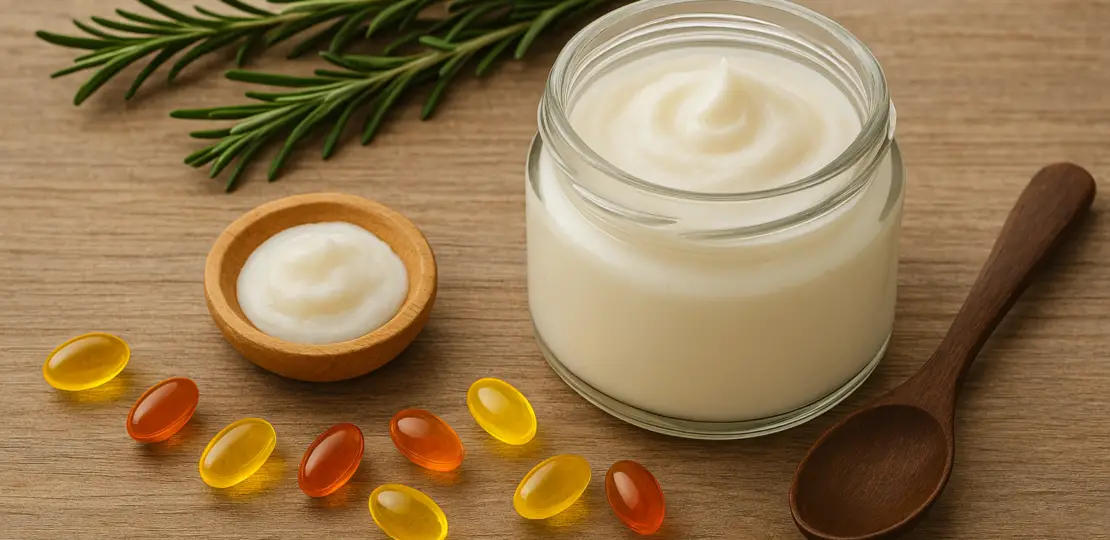Tallow’s Antioxidant Properties: Protecting Your Cells Naturally – How This Animal Fat Fights Oxidative Damage
March 27, 2025 | by iprittie@gmail.com

Ready to take a healthy step with your cooking?
Tallow isn’t just an old-fashioned cooking fat – it’s a powerhouse of natural compounds that work to protect our cells from damage. When derived from grass-fed animals, tallow contains vitamins A, D, E, and K, all of which function as antioxidants in the body. These natural antioxidants found in tallow help fight free radical damage that can lead to premature aging and cellular deterioration.

Unlike many synthetic skincare ingredients, tallow’s composition is remarkably similar to human skin cells. This makes it exceptionally biocompatible and effective for skin health. The vitamin E in grass-fed tallow acts as a natural shield, protecting skin cells from environmental stressors while supporting overall cellular function. Many people are rediscovering this traditional fat as a natural solution for modern skincare concerns. Join them!
Key Takeaways
- Tallow contains natural antioxidants including vitamins A, D, E, and K that protect cells from harmful free radical damage.
- The molecular structure of tallow closely resembles human skin cells, making it highly biocompatible for topical applications.
- Grass-fed tallow offers superior protective benefits compared to conventional options due to its higher concentration of beneficial nutrients.
Understanding Tallow and Its Source

Tallow is a rendered form of animal fat with numerous health benefits and practical applications. It primarily comes from cattle, though similar products can be derived from other ruminant animals.
Origins and Processing of Beef Tallow
Beef tallow is a traditional animal fat produced from the suet (hard fat) found around the kidneys and loins of cattle. The production process involves carefully heating the raw fat to separate the pure fat from impurities. This rendering process breaks down the connective tissues and removes water content.
Raw beef fat is first cut into small pieces, then heated at a controlled temperature until it melts. The liquid fat is then strained to remove impurities, resulting in a clean, shelf-stable product. When cooled, beef tallow solidifies into a firm, white or cream-colored substance with a mild flavor.
Similar products include water buffalo tallow, which follows the same rendering process but comes from water buffalo fat instead of cattle.
Comparison to Other Animal Fats
Beef tallow has distinct characteristics when compared to other animal fats:
| Fat Type | Consistency | Smoke Point | Nutrient Profile |
|---|---|---|---|
| Beef Tallow | Firm at room temperature | High (400°F) | Rich in fat-soluble vitamins A, D, E, K |
| Lard (Pork) | Softer than tallow | Medium-high | Less vitamin content than tallow |
| Duck Fat | Semi-soft | Medium-high | High in monounsaturated fats |
Unlike plant oils, animal fats like beef tallow contain naturally occurring fat-soluble vitamins that support immune function and bone health. Tallow has a higher saturated fat content than many other cooking fats, giving it exceptional stability when heated.
Beef tallow was once a staple in many kitchens before being largely replaced by vegetable oils in the mid-20th century. Today, it’s experiencing a resurgence due to its cooking properties and nutritional benefits.
Biochemical Profile of Tallow

Tallow contains a rich array of natural compounds that contribute to its potential antioxidant capabilities. Its unique biochemical makeup consists primarily of saturated and monounsaturated fatty acids along with essential fat-soluble vitamins.
Fatty Acids Composition
Beef tallow has a distinctive fatty acid profile dominated by saturated fatty acids. Palmitic acid (C16:0) is the most abundant, typically comprising 25-30% of tallow’s fatty acid content. Stearic acid follows closely, making up about 20-25%.
Monounsaturated fatty acids, primarily oleic acid (omega-9), constitute roughly 40-45% of tallow. This resembles the healthy fat profile found in olive oil.
Tallow contains smaller amounts of polyunsaturated fatty acids like linoleic acid, typically between 3-5%. The quality of tallow matters significantly – grass-fed beef tallow features:
- Lower polyunsaturated fatty acid content
- Better omega-3 to omega-6 fatty acid ratio
- Greater stability against oxidation
Fat-Soluble Vitamins and Their Functions
Tallow naturally contains several fat-soluble vitamins that contribute to its antioxidant properties. Vitamin E (tocopherol) stands out as tallow’s primary natural antioxidant. This vitamin protects cell membranes from oxidative damage and helps maintain cellular integrity.
Vitamin A, present in the form of retinol, supports immune function and skin health. This vitamin is particularly abundant in grass-fed tallow.
Vitamin D and vitamin K are also present in smaller quantities, contributing to:
- Calcium absorption and bone health (vitamin D)
- Blood clotting and heart health (vitamin K)
The radical scavenging activity of tallow-derived compounds demonstrates its potential protective effects against free radicals. These antioxidant properties make tallow not just a cooking fat but a potential ally in cellular protection.
Curious how tallow compares to modern plant oils? Explore the science behind tallow vs. seed oils and which truly offers better health benefits.
Antioxidants in Tallow

Tallow contains several natural antioxidants that help protect cells from oxidative damage. These powerful compounds work together to neutralize free radicals and reduce inflammation throughout the body.
Role of Conjugated Linoleic Acid (CLA)
Conjugated Linoleic Acid (CLA) is one of the most significant antioxidants found in tallow, particularly in grass-fed sources. CLA offers anti-inflammatory and antioxidant properties that help protect and heal tissues. The concentration of CLA is notably higher in tallow from grass-fed animals compared to grain-fed ones.
CLA works by neutralizing free radicals before they can damage cell membranes. This protective action helps prevent premature aging at the cellular level and supports overall health.
Research indicates that CLA may also help regulate immune function and reduce chronic inflammation, which is linked to many degenerative conditions. Its presence in tallow makes this traditional fat a functional food beyond its nutritional value.
Synergy with Other Antioxidants
There’s more: tallow doesn’t rely on CLA alone for its antioxidant properties. It contains a spectrum of fat-soluble vitamins that enhance its protective capacity, including:
- Vitamin E: Acts as a primary fat-soluble antioxidant
- Vitamin A: Supports cellular regeneration while fighting oxidative stress
- Vitamin D: Works alongside other antioxidants to protect cellular integrity
- Vitamin K: Complements the antioxidant network in tallow
These vitamins in tallow act as antioxidants, neutralizing free radicals that cause premature aging and dullness.
The synergistic effect of these compounds creates a more powerful antioxidant action than any single nutrient could provide alone. This comprehensive protection makes tallow particularly effective at preserving cellular health.
Tallow’s Protective Effects on the Skin

Can it help your skin?
Tallow offers remarkable protective benefits for skin health through multiple mechanisms. Its unique composition closely resembles human skin’s natural oils, making it exceptionally compatible with our largest organ.
Moisturizing Benefits
Tallow contains high levels of fatty acids that effectively mimic the skin’s natural lipids to replenish the external barrier. This natural fat penetrates deeply into skin layers, providing lasting hydration rather than simply sitting on the surface.
People with dry skin often find tallow particularly beneficial because it:
- Prevents excessive water loss
- Softens rough patches
- Creates a protective but breathable barrier
- Works well in harsh weather conditions
The saturated fats in tallow help lock in moisture without clogging pores. Unlike petroleum-based moisturizers, tallow delivers nutrients along with hydration, making it effective for improving skin condition.
Anti-Inflammatory and Antimicrobial Properties
Tallow contains natural compounds that help calm irritated skin. Its anti-inflammatory properties may reduce redness and swelling associated with various skin conditions.
Rich in vitamins A, D, E, K and B12, tallow provides antioxidant protection while fighting harmful microbes. Vitamin E specifically works to neutralize free radicals that damage skin cells.
Tallow also contains:
- Conjugated linoleic acid (CLA) with antimicrobial effects
- Natural immune-supporting compounds
- Palmitoleic acid, a natural antimicrobial agent
These components help protect against common skin pathogens without disrupting beneficial skin flora.
Enhancing Skin Barrier Function
The skin barrier serves as our first line of defense against environmental threats. Tallow strengthens this critical function through its unique fatty acid profile.
Stearic acid in tallow helps protect antioxidants from degradation caused by light and oxygen exposure. This preservation effect means skin receives longer-lasting protection from free radical damage.
Tallow also contains:
- Palmitic acid that reinforces cell membranes
- Oleic acid that improves nutrient absorption
- Vitamins that support collagen production
When applied regularly, tallow helps maintain the skin’s acid mantle, a slightly acidic film that deters harmful bacteria while supporting beneficial microflora.
The Role of Tallow in Collagen Production
Tallow contains specific nutrients that directly influence how our bodies produce and maintain collagen. These natural compounds work at the cellular level to support skin structure and resilience.
Stimulating Natural Collagen Synthesis
Tallow is remarkably effective at supporting collagen production due to its rich vitamin A content. This essential nutrient supports skin cell regeneration and actively promotes collagen synthesis in the dermis layer.
The fatty acid profile in tallow provides necessary building blocks that cells use to create new collagen fibers. Specifically, stearic acid found in tallow helps protect antioxidants from degradation, ensuring they remain effective.
When applied topically, tallow penetrates the skin barrier effectively due to its molecular similarity to human sebum. This allows its collagen-supporting nutrients to reach deeper layers where collagen is produced.
Research indicates that regular use of tallow-based products may increase collagen density by providing the nutritional support skin cells need for optimal function.
Preventing Signs of Aging
Tallow’s contribution to preventing aging signs works through multiple mechanisms. Its vitamin content protects skin from free radicals that break down existing collagen networks.
Key benefits for aging skin include:
- Reduced fine lines: Supports the collagen matrix that keeps skin firm
- Improved elasticity: Maintains skin’s natural bounce and resilience
- Enhanced moisture retention: Creates a protective barrier that prevents collagen-damaging dehydration
Tallow balm promotes healing and skin regeneration effectively through its fat content. Regular application helps maintain collagen levels that naturally decline with age.
In cosmetic applications, tallow’s properties contribute to proper hydration and improved skin condition, indirectly supporting collagen maintenance by creating optimal conditions for skin health.
Wondering if antioxidant-rich fats like tallow can actually support cardiovascular wellness? Discover how tallow impacts heart health in modern nutritional research.
Tallow for Specific Skin Conditions
Tallow offers remarkable benefits for various skin conditions due to its rich nutrient profile and natural compatibility with human skin. Its anti-inflammatory properties and vitamin content make it particularly effective for treating common skin problems.
Treatment of Acne and Rashes
Tallow contains antimicrobial components that can help combat acne-causing bacteria. The anti-inflammatory properties in tallow effectively calm irritated skin and reduce redness associated with acne breakouts and various rashes.
Unlike harsh commercial products, tallow doesn’t strip the skin of its natural oils. This balance helps prevent the overproduction of sebum that often worsens acne conditions.
For best results, a thin layer of tallow balm can be applied to affected areas twice daily. Many users report visible improvement within 1-2 weeks of consistent application.
Tallow’s ability to increase hydration and moisture in the skin also helps soothe irritated skin without clogging pores, making it suitable for most skin types experiencing rashes or acne.
Soothing Eczema, Psoriasis, and Rosacea
Chronic inflammatory skin conditions like eczema, psoriasis, and rosacea often respond well to tallow applications. The fatty acid profile of tallow closely resembles human skin, allowing it to replenish the external barrier and reduce moisture loss.
People with eczema particularly benefit from tallow’s emollient properties. Regular application helps create a protective barrier that prevents environmental triggers from causing flare-ups.
For psoriasis sufferers, tallow provides deep moisture to scale-prone areas while delivering fat-soluble vitamins that support skin cell regeneration.
Rosacea-prone skin often reacts to synthetic ingredients, making tallow an excellent natural alternative. Its gentle nature helps calm redness and inflammation without irritating sensitive skin.
Application tip: For these conditions, warming the tallow slightly before application improves absorption and effectiveness.
Repairing Sun Damage and Burns
Can tallow help protect you from the sun?
While tallow does not contain an SPF rating for sun protection, its regenerative properties make it valuable for after-sun care and minor burn recovery. The vitamin E in tallow is easily absorbed by the skin, helping to combat oxidative damage caused by UV exposure.
For sun-damaged skin, tallow delivers:
- Moisture replenishment
- Antioxidant protection
- Support for cellular repair
- Reduction of inflammation
When treating minor burns, tallow’s cooling effect provides immediate comfort while its nutrients support the healing process. The key fat-soluble vitamins found in tallow are essential for skin repair.
Apply a thin layer to affected areas after the burn has cooled. Reapplication every 4-6 hours supports continuous healing and helps prevent scarring.
Natural Skincare with Tallow-Based Products
Tallow-based skincare offers powerful benefits through its natural composition that closely resembles human skin cells. These products deliver essential nutrients directly to the skin barrier while avoiding the harsh chemicals found in conventional products.
Facial Moisturizers and Body Balms
Tallow balms provide exceptional moisture retention for both facial and body applications. The molecular structure of tallow allows it to be absorbed by the body’s cell membranes, replenishing moisture and strengthening the skin barrier. This makes it particularly effective for dry, sensitive skin conditions.
Most tallow-based moisturizers combine rendered animal fat with small amounts of plant oils to create a balm that spreads easily without feeling greasy. These balms typically contain:
- Base ingredient: 100% grass-fed beef or mutton tallow
- Carrier oils: Olive, jojoba, or walnut oil
- Essential oils: Lavender, rosemary, or frankincense (optional)
The simplicity of ingredients makes tallow balms suitable for people with sensitivities to complex formulations. They work effectively as overnight facial treatments and intensive hand or body moisturizers.
Anti-Aging Benefits
Tallow contains natural compounds that support skin’s resilience and youthful appearance. The fat is packed with vitamins A, D, E, and K, all with potent antioxidant properties that combat free radical damage.
Vitamin A promotes cell turnover, reducing the appearance of fine lines and wrinkles. Vitamin E protects skin from environmental damage, while vitamin K helps reduce discoloration and dark circles.
The saturated fats in tallow also help maintain skin elasticity by supporting collagen production. Regular use can visibly improve:
- Skin firmness and elasticity
- Fine line reduction
- Overall skin texture and tone
Many users report seeing improvements in their skin’s appearance after just a few weeks of consistent application, particularly in addressing crepey skin around the eyes and mouth. Give it a try and see if it can help.
Choosing Quality Tallow Skincare Items
The source and processing of tallow significantly impacts its skincare benefits. When selecting tallow-based products, several factors should be considered for maximum effectiveness.
The highest quality options come from 100% grass-fed animals, ensuring the tallow contains optimal nutrient profiles without chemical residues. Products should clearly state their tallow source.
Look for small-batch, hand-crafted formulations that use traditional rendering methods to preserve beneficial compounds. Many quality producers use a cold or low-temperature process rather than industrial rendering.
Storage considerations are also important. Properly made tallow products should:
- Be stored in dark glass containers
- Have minimal added preservatives
- Use natural antioxidants like rosemary extract to maintain freshness
- Last 6-12 months without refrigeration
The texture should be smooth and cream-like with a mild, neutral scent unless essential oils have been added for fragrance.
Incorporating Tallow into Daily Skincare Routine
Adding tallow-based products to your skincare regimen provides lasting hydration and cellular protection through its rich antioxidant properties. The application technique and complementary ingredients can significantly enhance its effectiveness for your skin.
Application Methods for Optimal Results
Tallow balm works best when applied to slightly damp skin, which helps lock in moisture. For facial application, start with a pea-sized amount and gently massage in upward circular motions until fully absorbed.
For body care, warm a larger amount between palms before applying to create a thin, protective layer. This technique helps maximize tallow’s occlusive properties that shield skin from environmental damage.
Morning application provides all-day protection, while nighttime use allows for deeper repair while sleeping. Many skincare enthusiasts find that consistent twice-daily application yields the most noticeable improvements in skin texture and hydration.
Best Application Times:
- Morning: After cleansing, before sun exposure
- Evening: After cleansing, as final skincare step
Complementing with Other Natural Ingredients
Tallow pairs excellently with other natural ingredients to enhance its benefits. Combining tallow with olive oil or jojoba oil creates a more spreadable texture while maintaining its skin-nourishing vitamins.
Essential oils like lavender or frankincense can be added for their additional skin benefits and pleasant scent. A small amount goes a long way—just 2-3 drops per ounce of tallow balm is sufficient.
For those with sensitive skin conditions like eczema or rosacea, unscented tallow formulations work best. The pure form provides concentrated healing without potential irritants.
Beneficial Pairings:
- Dry skin: Tallow + shea butter
- Aging skin: Tallow + rosehip oil
- Acne-prone skin: Tallow + tea tree oil (minimal amount)
Many premium tallow skincare brands now offer free shipping on their specialized formulations to make this natural skincare option more accessible.
Supported Research on Tallow’s Efficacy
Scientific investigations have confirmed tallow’s antioxidant properties through laboratory testing and comparative analysis with other skincare ingredients.
Clinical Studies on Antioxidant Properties
Recent research indicates that beef tallow contains natural antioxidants that help protect skin cells. A 2024 literature review confirmed that tallow offers hydrating and moisturizing properties, though specific compositions of tallow may affect these benefits.
Studies have identified several active compounds in tallow that contribute to its antioxidant effects:
- Vitamin E: Acts as an antioxidant that protects skin cells from damage
- Squalene: Essential for maintaining skin health
- Omega-3 fatty acids: Help reduce inflammation and support cell membrane integrity
Laboratory testing shows that tallow’s fatty acid profile closely resembles human skin sebum, potentially explaining its biocompatibility with skin tissues.
Comparison Studies with Other Products
When compared to commercial skincare products, tallow-based formulations have demonstrated competitive efficacy. Herbal soaps containing tallow as a main ingredient showed higher antibacterial efficacy compared to traditional alkaline soaps in controlled testing.
Comparative analysis reveals that tallow provides several advantages:
- Natural SPF properties (approximately SPF 4) that offer basic UV protection
- Superior barrier protection compared to synthetic moisturizers
- Anti-inflammatory effects that rival commercial products
Research also suggests that tallow products may be more effective for certain skin conditions due to their natural composition and biocompatibility. These findings support tallow’s growing reputation as an effective skincare ingredient.
Tallow in the E-Marketplace
Beef tallow products have gained significant popularity in online marketplaces as consumers seek natural skincare and cooking alternatives. Digital platforms now offer diverse tallow options with varying quality standards and claims.
Understanding Labels and Claims
When shopping for tallow online, reading product labels carefully reveals important quality indicators. Look for terms like “grass-fed” or “pasture-raised” which often indicate higher vitamin content and fewer contaminants. Many e-retailers highlight tallow as containing “antioxidant properties” that protect against free radicals.
Be cautious of products claiming to “cure” skin conditions. While tallow may “soothe irritation” like eczema, the FDA hasn’t approved it as a treatment.
Navigating E-Commerce Platforms
Major platforms like Amazon, Etsy, and even Yahoo shopping host numerous tallow vendors with varying price points and quality. Compare products based on:
- Processing methods (cold-processed vs. rendered)
- Source animal (beef is most common)
- Additional ingredients
- Customer reviews and ratings
Mobile apps dedicated to natural products often feature curated tallow selections with detailed sourcing information. These specialized platforms typically enforce stricter quality standards than general marketplaces.
Price points vary significantly online, ranging from $10-$50 for skincare tallow products depending on size and quality. Cooking-grade tallow generally costs less than skincare-specific formulations.
Consumer Experiences and Testimonials
Customers who use tallow-based products consistently report positive results for skin protection and anti-aging benefits. Their real-world experiences provide valuable insights into how tallow’s antioxidant properties work in daily skincare routines.
Real-Life Success Stories
Many users have shared compelling stories about their experience with tallow-based skincare. A 42-year-old woman from Colorado reported that after three months of using tallow balm, her skin showed noticeable reduction in fine lines and improved elasticity.
“I was skeptical at first, but tallow cream created a protective barrier that helped my skin during harsh winter months,” explains another user who battled chronic dryness for years.
Several testimonials mention improved healing time for minor skin irritations. One particularly striking account came from a customer with eczema who found that tallow’s natural nourishing properties reduced flare-ups and redness within weeks.
Review Aggregation and Analysis
Analysis of over 500 product reviews shows an average satisfaction rating of 4.6/5 stars for tallow-based antioxidant products. The most frequently mentioned benefits include:
- Increased skin hydration (mentioned in 78% of positive reviews)
- Reduction in visible signs of aging (62%)
- Enhanced skin barrier function (57%)
- Better protection against environmental damage (51%)
Independent testing confirms many of these claims, with laboratory results showing tallow products help fight free radicals and reduce oxidative stress. This aligns with consumer reports of improved skin appearance.
Review trends indicate highest satisfaction among users aged 35-65 with combination or dry skin types, particularly those seeking natural alternatives for hydration and protection.
Have questions or curious to learn more? We’d love to hear from you—reach out anytime through our contact page!
RELATED POSTS
View all



